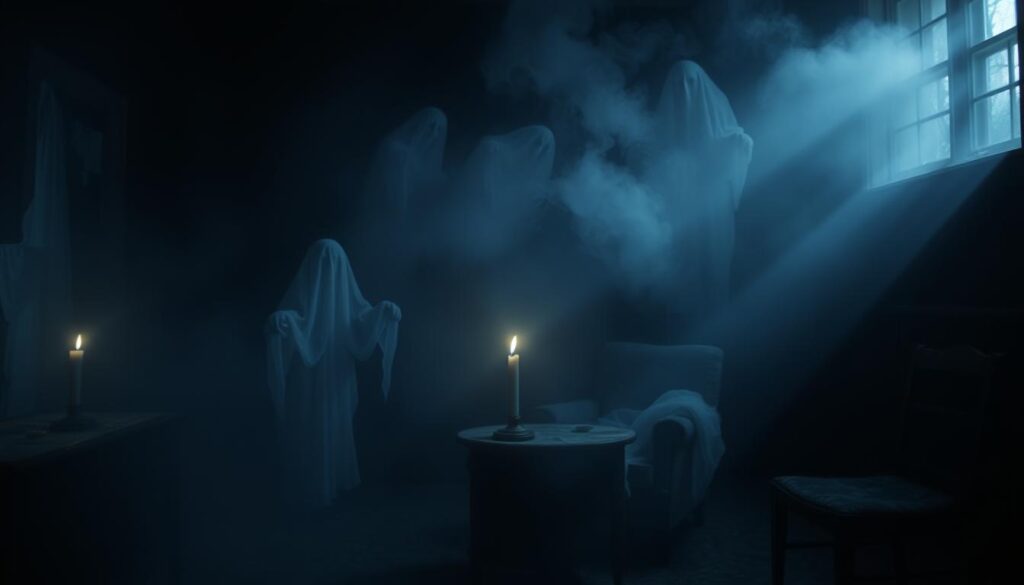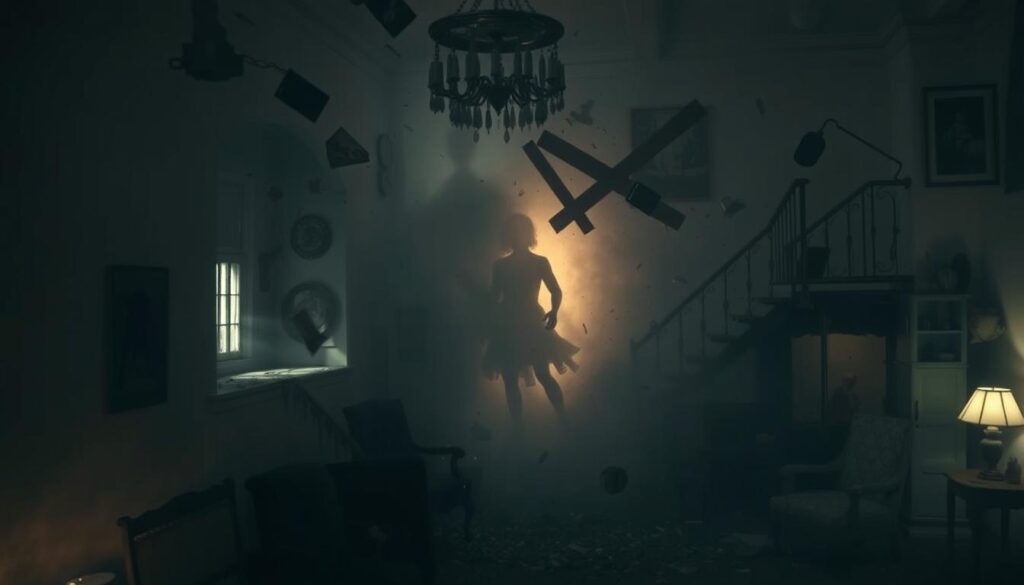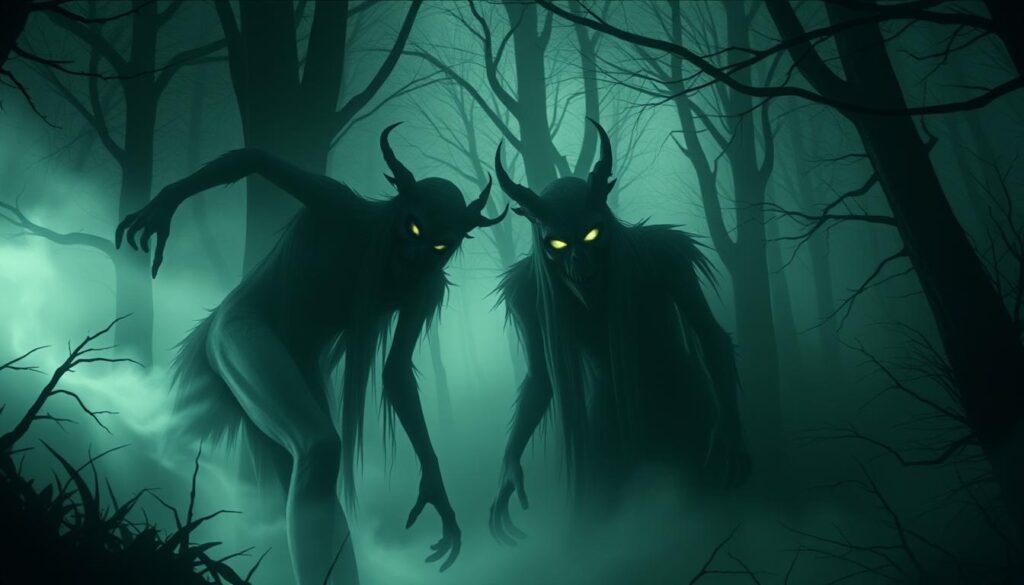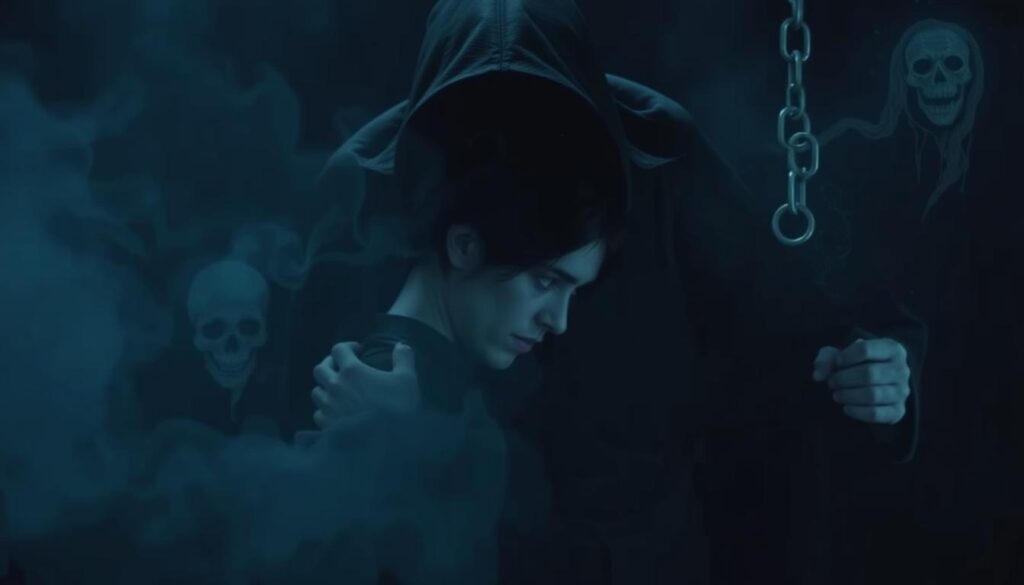The world of the paranormal is vast and fascinating. It’s filled with supernatural events that grab the attention of many. Ghosts and poltergeists are two mysterious beings often mixed up. This guide will help you understand the differences between them, including their origins and how they interact with our world.
Key Takeaways
- Ghosts and poltergeists are distinct paranormal entities with unique origins and characteristics.
- Ghosts are typically the spirits of deceased individuals, while poltergeists are associated with psychokinetic energy and disturbances.
- Ghosts can display a range of behaviors, from becoming visible to emitting odors, while poltergeists are known for their ability to interact with the physical environment.
- Identifying the presence of a ghost or poltergeist can be challenging, as they often exhibit similar signs such as unexplained noises or the movement of objects.
- Understanding the differences between these paranormal entities is crucial for conducting effective investigations and addressing haunting occurrences.
What are Ghosts?
Ghosts are the spirits of people who have died but haven’t moved on to the afterlife. These human spirits can be found in many haunted locations. This includes homes, workplaces, parks, and forests.
Ghosts often keep the same personality they had when alive. Nice spirits usually leave people alone. But, those who were mean in life might act disruptive or even aggressive.
Characteristics of Ghosts
Ghosts show their presence in many ways. They can be seen, cause temperature changes, make unexplained noises, and move objects. These paranormal activities happen when spirits want to talk to the living or finish something left undone.
Some ghosts are believed to be animals, not just humans. These types of ghosts act like their living friends. They might be playful or protective.
“Ghosts are the shadows of the living, reminders that the world we inhabit is more than just the physical plane.”
| Characteristic | Description |
|---|---|
| Appearance | Ghosts are often seen as greyish-pale, sometimes transparent or translucent. |
| Behavior | Ghosts can be benevolent and helpful or malevolent and disruptive. |
| Interaction | Ghosts can interact with the physical world in various ways. They can move objects, manipulate temperatures, and produce unexplained sounds. |
Reasons for Ghostly Encounters
Ghosts often appear when someone dies with unfinished business or in a sudden, violent way. They might stay to talk to loved ones, seek justice, or refuse to accept death. Some ghosts are tied to certain places, like their old homes, causing paranormal activity and ghost sightings.
The Book of Shadows talks about different kinds of ghosts. Influences are the mildest, showing up as vague feelings in places or objects. Poltergeists, or “noisy ghosts,” cause trouble with loud noises and moving things. Apparitions, the classic ghosts, look like shadowy figures that disappear and are often found in old places.
Phantasms of the living are when someone alive shows up in a different place. This usually means they’re about to die or have an urgent message. Hauntings happen when ghosts and poltergeists cause lots of psychic activity, lasting for years or even centuries.
| Paranormal Phenomenon | Description |
|---|---|
| Influences | Vague feelings that attach to places or objects |
| Poltergeists | Noisy ghosts that demonstrate destructive outbursts of energy |
| Apparitions | Shadowy figures that vanish and are often linked to historical locations |
| Phantasms of the Living | Apparitions of still-alive individuals appearing in one place while their physical bodies are elsewhere |
| Hauntings | High-rate or intense psychic phenomena that can stretch over years or centuries |
The agent theory says poltergeist activity often centers around a young woman under 20. She might be unconsciously moving things due to stress or poor health. Researchers think poltergeists driven by agents don’t communicate and stop when the person is no longer stressed.
Ghosts are spirits of people who died, often because of unfinished business or traumatic deaths. They might show up as sightings, change room temperatures, or bring strange smells. Poltergeists, however, are seen as different, able to physically interact and even harm people.
Signs of a Ghostly Presence
If you think you might have a ghost around, watch for certain signs. These can include sudden temperature changes, strange sounds, and movements. These signs often point to supernatural activity.
A sudden drop in temperature is a common sign. Infrasound, with frequencies between 0.1 and 20 Hz, can impact human senses and create feelings of unease or eerieness in the environment. You might also smell perfume or flowers out of nowhere, which could mean a spirit is near.
Unusual noises, like footsteps or voices, can also hint at a ghost. Approximately 20-30 degree temperature drops or frigid cold spots in specific areas of a room are often associated with ghostly presences. Electrical issues, like flickering lights or ringing phones, are other signs.
- Feeling a sudden presence or the sensation of being watched without a visible source
- Experiencing strange physical sensations, like hair tugs or shoulder taps
- Witnessing the movement of objects, such as doors opening or items disappearing and reappearing
- Observing shadows or movement in the corner of your eye
- Noticing unusual behavior from pets, who may focus on specific areas or react to unseen entities
If you see these signs together, it might mean you’re dealing with a ghost. But remember, not everything strange is paranormal. Keep an open mind and seek help if you need it.

Difference between Ghosts and Poltergeists Explained
Ghosts are spirits of people who have passed away. Poltergeists, on the other hand, are a special kind of spirit. They are known as “noisy ghosts” because they can make a lot of noise.
They can make objects move, break, or fly around the room. Even though they can’t be seen, they can be very violent and angry. They often get their energy from the emotions of those around them.
What makes poltergeists different is their ability to physically interact with the world. They tend to follow a person rather than stay in one place. This makes them unique in the world of spirits.
They are linked to psychokinetic disturbances. This means they can move things without touching them. Their actions can be very noisy and disruptive.
Poltergeist Characteristics
- Ability to interact with the physical environment
- Tendency to be angry and violent
- Feed off the emotional energy of people around them
- Follow a specific person rather than a location
- Associated with psychokinetic disturbances and object manipulation
It’s important to know the difference between ghosts and poltergeists. Both can be scary, but poltergeists are more active and physical. This makes them stand out from ghosts.
“Poltergeists are a unique and intriguing aspect of the paranormal, challenging our understanding of the boundaries between the physical and spiritual realms.”
Understanding Poltergeists
The origins of poltergeists are not well understood. Some think they are a special kind of ghost. Others believe they are a result of psychokinetic energy. Poltergeists are known for causing trouble and fear. They can move objects, make strange noises, and even attack people.
Poltergeists are different from ghosts because they are often connected to a living person. This person is usually young and going through tough times. Their psychokinetic energy can turn into supernatural disturbances and haunting experiences.
At first, poltergeist activity is small. But it gets worse over time. Objects move, doors slam, and strange noises happen. Some say the activity is linked to a person’s emotions or psychic powers.
| Characteristic | Ghosts | Poltergeists |
|---|---|---|
| Origin | Believed to be the spirits of deceased individuals | Associated with psychokinetic energy disturbances, not necessarily deceased spirits |
| Behavior | Manifestations such as appearing in specific locations and interacting with the living | Disruptive behaviors like moving objects, loud noises, and physical attacks |
| Linked to Individual | Not necessarily tied to a specific person | Often linked to a living individual experiencing emotional or psychological stress |
It’s important to know about poltergeists to deal with supernatural disturbances. By understanding poltergeists, we can handle haunting experiences better.

Demonic Entities: What Are They?
Demonic entities are seen as the most evil supernatural beings. They are fallen angels or “lower gods” with great powers. Unlike ghosts, demons are their own kind that can harm and control the living, making them do bad things.
Characteristics of Demons
Demons are feared for their power to tempt and take over people. They can change shape, make people sick, and even drive them crazy. Demons have been linked to many religions and occult groups. They are seen as agents of evil and destruction.
- Demonic entities are considered “fallen angels” or “lower gods” with immense supernatural powers.
- Unlike ghosts or poltergeists, demons are their own distinct entities that can physically and mentally manipulate the living.
- Demons are known for their insidious and malevolent nature, as they can tempt and possess individuals, leading them to commit evil acts.
- Historically, demons have been associated with various religious and occult traditions, often serving as intermediaries or independent operators responsible for various forms of evil and destruction.
- Demons are believed to have a wide range of supernatural powers, including shape-shifting, inflicting diseases, and even causing insanity.
The public’s interest in the paranormal is growing. Ghost-hunting services and psychics are becoming more popular. This shows a rise in fascination with the spiritual world, including demons. But, it’s crucial to be careful. The influence of spiritual deception can be misleading and dangerous.

“Demons are feared for their alleged ability to possess living creatures, a belief that remains prevalent in many modern religions and occult traditions.”
Vulnerability to Demonic Possession
People who are emotionally, mentally, or spiritually weak are more at risk for demonic possession. Emotional turmoil, desperation for help, and not being able to think clearly can make someone more open to dark entity temptations. Once a demon gets in, it can make the person do harmful things, making them believe it’s their choice.
A 1969 study by the National Institute of Mental Health found that spirit-possession beliefs were common in 74% of 488 societies. The highest rates were in Pacific cultures, and the lowest among Native Americans. As Pentecostal and Charismatic Christian churches grow in Africa and Oceania, beliefs are mixing. This leads to Christian ministers trying to exorcise demons seen as traditional spirits.
The New Testament shows Jesus casting out demons from people. This suggests that possession can happen by choice or without it. Roman Catholic teaching says angels and demons are spirits with will and intelligence. They can take over a person without their consent, making the person blameless.
Also, Catholic exorcists say Satanic/demonic actions can show in six ways, from slight influence to full body possession. This shows how complex and varied demonic possession is. It’s important to understand and handle it with care and sensitivity.

The Catholic Encyclopedia mentions a single apparent case of demonic possession in the Old Testament, relating to King Saul being tormented by an “evil spirit,” but this interpretation is considered uncertain.
Identifying a Haunting
Knowing the signs of a haunting is key to understanding what’s happening. Common signs include strange noises, moving objects, sudden temperature changes, and feeling watched. These are all signs of paranormal activity.
Not every spiritual disturbance is a haunting. It’s vital to look closely at the signs to figure out what’s happening. This could be a ghost, a poltergeist, or something else.
- Unexplained noises, like knocks or bangs, might mean a haunting.
- Seeing objects move by themselves is a clear sign of paranormal activity.
- Cold spots or sudden temperature changes could be ghostly.
- Feeling watched, even when alone, suggests supernatural phenomena.
If you’re seeing these signs, it’s crucial to investigate and document them. This will help you understand the unexplained occurrences you’re facing.
“Nearly half of Americans believe in ghosts based on a 2005 Gallup poll.”
By recognizing the signs of a haunting, you can take steps to address the spiritual disturbances. If it’s too much, consider seeking professional help.
Paranormal Investigations and Research
In the world of the paranormal, research has revealed much about ghosts and other supernatural beings. Brave researchers and ghost hunters work hard to find evidence and understand these mysteries. They aim to develop ways to deal with these phenomena.
These individuals use many tools and methods to advance our knowledge. They use new technology and old methods to learn about the paranormal. Their work helps us understand the unseen forces that might be around us.
Collecting evidence is a key part of paranormal research. Investigators carefully document their findings and analyze data. This work helps us understand ghostly encounters and unexplained events better.
Research has also led to new ways to handle paranormal activity. These methods help people dealing with hauntings and reduce the impact of supernatural events. The work of these researchers is very important in this field.
The work of these investigators is crucial for understanding the paranormal. Their efforts help us learn more about the supernatural. They are working to uncover the secrets of the unknown.
| Statistic | Insight |
|---|---|
| Poltergeist activity has been recorded in various cultures and countries, including Brazil, Australia, the United States, Japan, and most European nations. | The prevalence of poltergeist activity across diverse regions suggests a widespread and persistent phenomenon that transcends cultural boundaries. |
| The first recorded cases of poltergeist activity date back to the 1st century. | The longstanding historical record of poltergeist encounters underscores the enduring nature of this paranormal phenomenon. |
| Many claims of poltergeist activity have been proven upon investigation to be hoaxes. | The need for critical analysis and thorough investigation is crucial in distinguishing genuine paranormal events from deliberate deceptions. |
As the field of paranormal investigations grows, researchers and fans are eager to solve the mysteries of the supernatural. They use science and an open mind to find the truth. Their work helps us understand the unexplained phenomena that have fascinated us for centuries.
“The pursuit of the paranormal is not just about uncovering the truth; it’s about expanding the boundaries of our understanding and embracing the wonders of the unknown.”
Haunted Locations and Hotspots
Throughout history, some haunted locations have become famous for being paranormal hotspots. They draw in ghost fans and researchers. These places, like old buildings and eerie forests, are said to have a lot of spirit activity. People report ghost sightings and strange happenings.
The Portsmouth Poltergeist is a famous case. It happened in a family’s home in Virginia. Objects moved by themselves and strange noises were heard. The family had to leave because of it. Learning about these haunted locations helps us understand the paranormal.
| Haunted Location | Reported Activity | Notable Incidents |
|---|---|---|
| The Winchester Mystery House, California | Ghostly sightings, unexplained noises, doors and windows opening/closing on their own | The house was built by Sarah Winchester, who believed she was cursed by the spirits of those killed by the Winchester rifle. Construction continued 24/7 for over 38 years. |
| The Stanley Hotel, Colorado | Apparitions, unexplained sounds, doors slamming, objects moving | The hotel inspired Stephen King’s novel “The Shining” and is featured in numerous ghost-themed TV shows and films. |
| Edinburgh Castle, Scotland | Ghostly soldiers, disembodied voices, unexplained footsteps | The castle has a long history of violent battles and executions, making it a renowned paranormal hotspot. |
Exploring haunted locations can be exciting and educational. From the Portsmouth Poltergeist to the Winchester Mystery House, there’s much to discover. These paranormal hotspots offer a glimpse into the unknown.
“The greatest trick the devil ever pulled was convincing the world he didn’t exist.” – Charles Baudelaire
Paranormal Tourism and Ghost Tours
The paranormal world has sparked a booming industry. Paranormal tourism and ghost tours are now big. People and companies lead tours to haunted locations, hoping to catch a glimpse of the unknown.
These tours are a hit with paranormal enthusiasts. They also help us learn about the mysterious happenings in these places.
A 2018 survey showed 58 percent of Americans believe in haunted places. A Pew Research Center study found nearly one in five people have seen a ghost.
Ghost tours are popular worldwide. In 2003, Savannah, Georgia, had over 31 tours. A group in Illinois saw its tour attendees jump from 600 in 2006 to 1,800 in 2008.
| Location | Number of Ghost Tours | Year |
|---|---|---|
| Savannah, Georgia | 31+ | 2003 |
| Illinois (A Midwest Haunting) | 600 to 1,800 | 2006 to 2008 |
Paranormal tourism has also boosted small businesses. They sell ghost-hunting equipment and offer paranormal investigation services. Tools like EMF meters and infrared sensors have been big sellers since the early 2000s.
But paranormal tourism does more than just entertain. It also helps researchers like Dr. David Smailes at Northumbria University. They study how people see faces in random images, a sign of pareidolia. This research sheds light on our brains and how we see the world.
“Ghost narratives are compared to bottle trees in the Southern African American culture, serving as a means to capture and contain spirits that could cause harm.”
As the paranormal tourism industry grows, so does our understanding of it. Researchers explore its cultural, technological, and psychological sides. Their findings help us grasp the role of ghosts in today’s folklore and society.
Conclusion
As we wrap up our look into ghosts vs. poltergeists, it’s clear they’re more than just our imagination. We’ve dug deep into the differences between these entities. This includes the lasting impact of “Poltergeist” on our understanding.
This guide has covered everything from ghost and poltergeist traits to theories on demons and ghost hunting. It’s aimed at both seasoned fans and the curious. Now, you have the knowledge to spot and understand these mysterious events.
As we say goodbye, remember the world is full of secrets and wonder. Stay open-minded, and you might find yourself in a paranormal adventure. The quest to uncover the unknown goes on. We hope this article has been a helpful guide for you.
FAQ
What are the key differences between ghosts and poltergeists?
Ghosts are spirits of people who have died. Poltergeists, on the other hand, are entities that can move objects and cause trouble. They are not seen but can be very loud and violent.
What are the common characteristics of ghosts?
Ghosts can be found in many places. They often act like they did when they were alive. Some ghosts are friendly, while others can be mean.
They show their presence in many ways, like changing the temperature or making strange noises.
What are the reasons for ghostly encounters?
Ghosts often appear because of unfinished business or a sudden death. They might want to talk to loved ones or find justice. Some ghosts stay in places that were important to them.
What are the signs of a ghostly presence?
Signs of ghosts include sudden cold or hot spots, strange smells, and feeling watched. You might also hear strange noises or see objects move by themselves.
How are poltergeists different from ghosts?
Poltergeists can move things and cause trouble, unlike ghosts. They are not seen but can be very loud and angry. They follow people around, unlike ghosts that stay in one place.
What is the origin of poltergeists?
The exact origin of poltergeists is not known. Some think they are a special kind of ghost. Others believe they are made of energy. They are known for causing trouble and being scary.
What are demons, and how do they differ from ghosts and poltergeists?
Demons are evil beings from the supernatural world. They are not spirits of the dead but have their own power. They can make people do bad things and are very dangerous.
What factors make someone vulnerable to demonic possession?
People who are emotionally or mentally weak are more likely to be possessed by demons. Feeling sad, desperate, or unable to think clearly can make someone more open to demonic influence.
How can you identify a haunting?
Signs of a haunting include strange noises, moving objects, and sudden temperature changes. Feeling watched or followed is also common. Not all strange experiences are hauntings, so it’s important to understand what you’re dealing with.
How do paranormal researchers and investigators study these phenomena?
Paranormal researchers use many tools and methods to study ghosts, poltergeists, and other entities. They aim to find evidence, understand why these things happen, and find ways to deal with them.
What are some notable haunted locations and hotspots?
Some places are known for being haunted and attract many people. These include old buildings, historic sites, forests, and battlefields. They are believed to have a lot of spiritual activity, with reports of ghostly sightings and strange occurrences.
How has the fascination with the paranormal led to the growth of paranormal tourism?
The interest in the paranormal has created a big industry of ghost tours and paranormal tourism. People can go on guided tours of haunted places to see if they can find any supernatural activity. These tours are exciting for fans of the paranormal and help us learn more about these mysterious places.
Source Links
- What’s the Difference Between a Ghost, Poltergeist, and Demons? | Sithra Institute – https://medium.com/@sithrainstitute/whats-the-difference-between-a-ghost-poltergeist-and-demons-sithra-institute-72ebdc096201
- Types Of Ghosts and Spirits – https://www.ghostsandgravestones.com/types-of-ghosts
- Ghosts, poltergeists, and demons: What’s the difference? – https://www.nightmaretoys.com/blogs/news/ghosts-poltergeists-and-demons-whats-the-difference?srsltid=AfmBOootK712GIZci2f7cTU2rXuZ6GwS7N9qQ6CDZxfSlk0AoKgbT4oe
- Ghosts, poltergeists, and demons: What’s the difference? – https://www.nightmaretoys.com/blogs/news/ghosts-poltergeists-and-demons-whats-the-difference?srsltid=AfmBOooPSaNG3WbVig-0jKFJRNBjPVcd3fo93AH-6NutXqAxAG1ha_1d
- Poltergeist – https://harrypotter.fandom.com/wiki/Poltergeist
- Types of Hauntings | Haunted Orange County – https://hauntedoc.com/types-of-hauntings/
- Ghosts, Poltergeists Hauntings – https://charmedlegacy.fandom.com/wiki/Ghosts,_Poltergeists_Hauntings
- Poltergeists – https://dannyechase.com/blog/poltergeists/
- The Difference Between Ghosts, Poltergeists, & Demons That Will Clarify Which Supernatural Entities You Should Be Terrified Of – https://www.bustle.com/p/the-difference-between-ghosts-poltergeists-demons-that-will-clarify-which-supernatural-entities-you-should-be-terrified-of-12607216
- 10 Signs Your House Is Haunted (And What to Do About It) – https://www.teenvogue.com/story/10-signs-your-home-may-be-haunted
- Case Study of Recognition Patterns in Haunted People Syndrome – https://www.ncbi.nlm.nih.gov/pmc/articles/PMC9216229/
- 10 Signs Your House Is Haunted – https://www.dummies.com/article/body-mind-spirit/religion-spirituality/the-paranormal/10-signs-your-house-is-haunted-266026/
- Ghosts, poltergeists, and demons: What’s the difference? – https://www.nightmaretoys.com/blogs/news/ghosts-poltergeists-and-demons-whats-the-difference?srsltid=AfmBOoqkcHJ9oiF2usvzs503TVtGfngrIdZiFbEm4bGy_svhCNNQcpTn
- Understanding Poltergeists: Meaning, Signs, and Stories – Centre of Excellence – https://www.centreofexcellence.com/poltergeists-meaning-signs-stories/
- Ghosts, poltergeists, and demons: What’s the difference? – https://www.nightmaretoys.com/blogs/news/ghosts-poltergeists-and-demons-whats-the-difference?srsltid=AfmBOoqMxi7J4HCJG-5xiVDQPoj0XveXuO6Aky-IxGUF4_lZBSxyRS-H
- What does the Bible say about ghosts / hauntings? – https://www.gotquestions.org/ghosts-hauntings.html
- Demon – https://en.wikipedia.org/wiki/Demon
- Spirit possession – https://en.wikipedia.org/wiki/Spirit_possession
- Delusions of Possession and Religious Coping in Schizophrenia: A Qualitative Study of Four Cases – https://www.ncbi.nlm.nih.gov/pmc/articles/PMC8017190/
- More Things in Heaven and Earth: Spirit Possession, Mental Disorder, and Intentionality – Journal of Medical Humanities – https://link.springer.com/article/10.1007/s10912-018-9519-z
- Ghosts, poltergeists, and demons: What’s the difference? – https://www.nightmaretoys.com/blogs/news/ghosts-poltergeists-and-demons-whats-the-difference?srsltid=AfmBOooOIGK61-kjxgTd0q3TY9KuICERnhvDvPFGoEwUp1tRBgM_vsgu
- Poltergeists: Noisy Spirits – https://www.livescience.com/38223-poltergeists.html
- Poltergeist – https://en.wikipedia.org/wiki/Poltergeist
- Are ghosts real? A social psychologist examines the evidence – https://sc.edu/uofsc/posts/2023/10/conversation-are-ghosts-real.php
- Is That a Ghost? Vibroacoustic Explanations for False Poltergeists – https://www.comsol.com/blogs/is-that-a-ghost-vibroacoustic-explanations-for-false-poltergeists
- Why are Poltergeists Always in the Kitchen – https://nathaliebonilla.medium.com/why-are-poltergeists-always-in-the-kitchen-a1d72a478c96
- The Eight Stages of a Poltergeist Haunting – https://livinglibraryblog.com/the-eight-stages-of-a-poltergeist-haunting/
- Ghost hunting – https://en.wikipedia.org/wiki/Ghost_hunting
- The science of ghosts – https://www.snexplores.org/article/science-ghosts
- Haunting Experiences: Ghosts in Contemporary Folklore – https://digitalcommons.usu.edu/cgi/viewcontent.cgi?article=1017&context=usupress_pubs
- What Really Happened During the Making of ‘Poltergeist’ – https://www.vanityfair.com/hollywood/2022/09/poltergeist-at-40
- Microsoft Word – Revised final singlespaced.doc – https://uhra.herts.ac.uk/bitstream/handle/2299/7184/Paul Day (Cowdell) – final PhD submission.pdf?sequence=1&isAllowed=y

